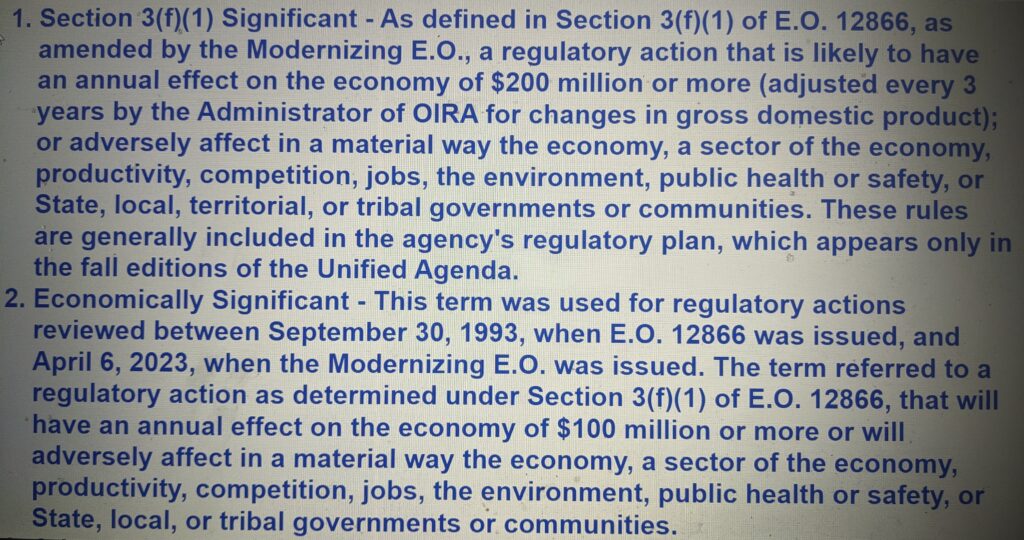Friends and allies in the liberty movement still often refer to high-cost regulations from the Biden administration as “economically significant” rules.
What hasn’t quite sunk in is the fact that, thanks to Joe Biden’s April 2023 Executive Order 14094 dubbed “Modernizing Regulatory Review, ” the term “economically significant” is now officially retired. I trace the devolution in a new article at Forbes and also cover how ambiguity that persists in some government publications may contribute to confusion over nomenclature.
Historically, since the Clinton administration’s Executive Order 12866, a regulation was considered “economically significant” if it was likely to have an annual (up or down) effect of $100 million or more. This designation played a big role in regulatory policy circles, indicating rules that required more thorough review due to their substantial economic effects.
While “economically significant” was never explicitly defined in law or presidential orders, as I detail elsewhere, it was nonetheless a widely accepted convention used by OMB and regulatory agencies to categorize substantial regulatory actions.
Biden’s Executive Order 14094 has altered this landscape by raising the threshold to $200 million annually. That part is well known. Less well known is the replacement of the old term with the new and far less melodic “Section 3(f)(1) Significant” rule.
Even some government websites remain behind the curve. For example, the reginfo.gov FAQ page still describes “economically significant” rules by relating the tale of the now jettisoned $100 million threshold.
The Unified Agenda of Federal Regulatory and Deregulatory Actions on the other hand reflects Biden’s change by referring to “economically significant” in the past tense. But it does so only within a pop-up bubble on the Advanced Search page, as seen here:

That screenshot is for posterity, in case the hover-button disappears.
Further reflecting the transition, the Biden administration’s updated Circular A-4 guidance on Regulatory Review omits the term “economically significant” entirely, even though it appeared in the introduction of the prior Obama rendition.
Biden’s modifications in regulatory policy hold substantial implications for transparency. With fewer rules likely to meet the new $200 million threshold, there will be less scrutiny and fewer comprehensive cost-benefit analyses. Congress should monitor these developments closely and consider passing regulatory reform bills to ensure better oversight.
Beyond that obvious takeaway, the confusion over regulatory classification and nomenclature amid these transformations signals a broader need to develop more precise classification systems for understanding the societal and economic effects of federal regulations and guidance documents.
While the term “economically significant” might linger in discussions even after its demise, it no longer plays any role in official regulatory language. The Biden administration’s new terminology reflects a significant shift in how regulatory impacts are assessed and classified.
The post The end of the ‘economically significant’ rule appeared first on Competitive Enterprise Institute.
What hasn’t quite sunk in is the fact that, thanks to Joe Biden’s April 2023 Executive Order 14094 dubbed “Modernizing Regulatory Review, ” the term “economically significant” is now officially retired. I trace the devolution in a new article at Forbes and also cover how ambiguity that persists in some government publications may contribute to confusion over nomenclature.
Historically, since the Clinton administration’s Executive Order 12866, a regulation was considered “economically significant” if it was likely to have an annual (up or down) effect of $100 million or more. This designation played a big role in regulatory policy circles, indicating rules that required more thorough review due to their substantial economic effects.
While “economically significant” was never explicitly defined in law or presidential orders, as I detail elsewhere, it was nonetheless a widely accepted convention used by OMB and regulatory agencies to categorize substantial regulatory actions.
Biden’s Executive Order 14094 has altered this landscape by raising the threshold to $200 million annually. That part is well known. Less well known is the replacement of the old term with the new and far less melodic “Section 3(f)(1) Significant” rule.
Even some government websites remain behind the curve. For example, the reginfo.gov FAQ page still describes “economically significant” rules by relating the tale of the now jettisoned $100 million threshold.
The Unified Agenda of Federal Regulatory and Deregulatory Actions on the other hand reflects Biden’s change by referring to “economically significant” in the past tense. But it does so only within a pop-up bubble on the Advanced Search page, as seen here:

That screenshot is for posterity, in case the hover-button disappears.
Further reflecting the transition, the Biden administration’s updated Circular A-4 guidance on Regulatory Review omits the term “economically significant” entirely, even though it appeared in the introduction of the prior Obama rendition.
Biden’s modifications in regulatory policy hold substantial implications for transparency. With fewer rules likely to meet the new $200 million threshold, there will be less scrutiny and fewer comprehensive cost-benefit analyses. Congress should monitor these developments closely and consider passing regulatory reform bills to ensure better oversight.
Beyond that obvious takeaway, the confusion over regulatory classification and nomenclature amid these transformations signals a broader need to develop more precise classification systems for understanding the societal and economic effects of federal regulations and guidance documents.
While the term “economically significant” might linger in discussions even after its demise, it no longer plays any role in official regulatory language. The Biden administration’s new terminology reflects a significant shift in how regulatory impacts are assessed and classified.
The post The end of the ‘economically significant’ rule appeared first on Competitive Enterprise Institute.
